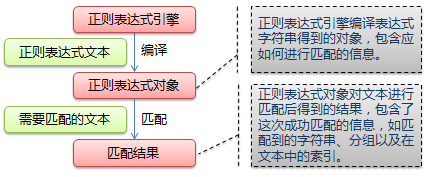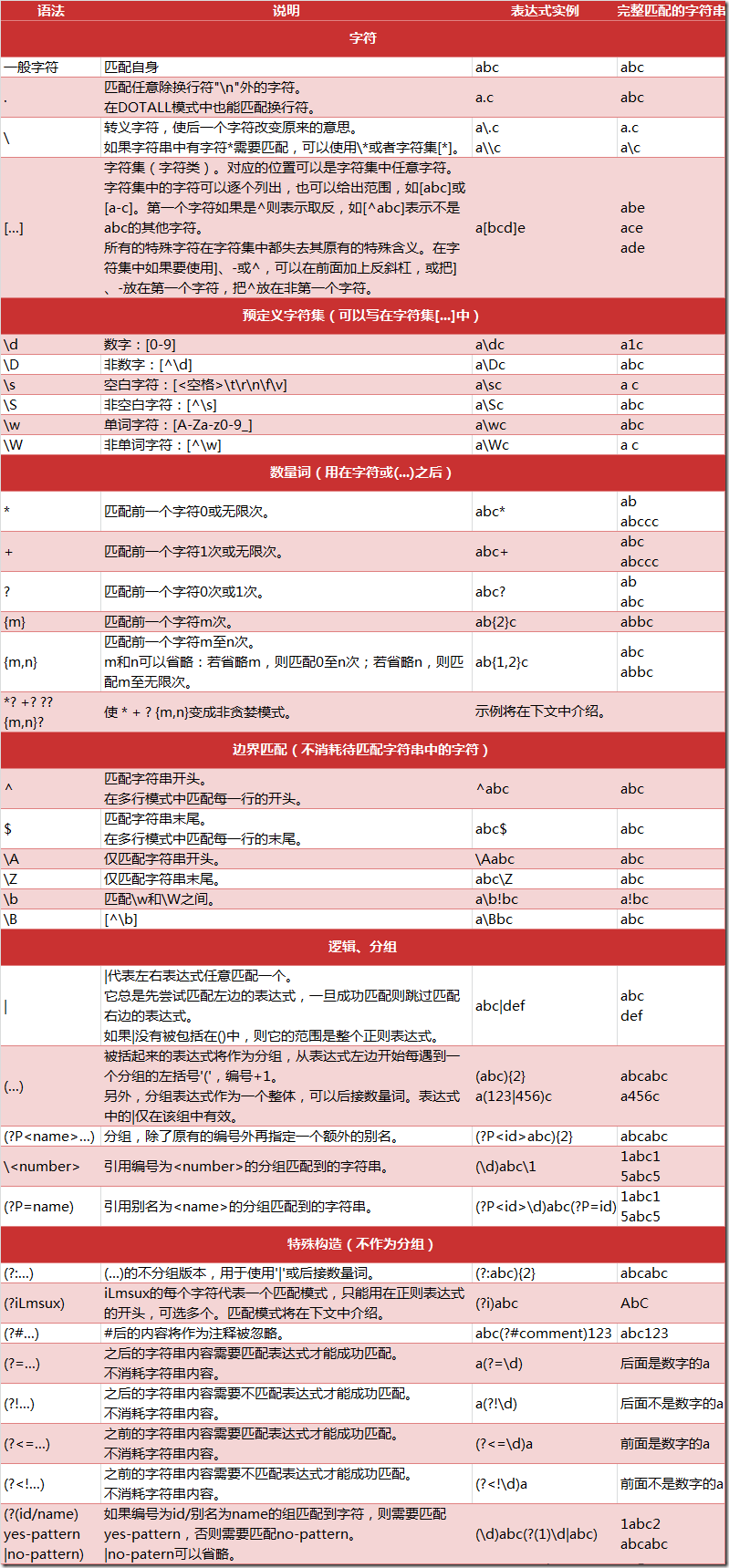以下内容转自CNBLOG:http://www.cnblogs.com/huxi/archive/2010/07/04/1771073.html
整理时没有注意,实在抱歉。
一、 正则表达式基础
1.1.概念介绍正则表达式是用于处理字符串的强大工具,它并不是Python的一部分。
其他编程语言中也有正则表达式的概念,区别只在于不同的编程语言实现支持的语法数量不同。
它拥有自己独特的语法以及一个独立的处理引擎,在提供了正则表达式的语言里,正则表达式的语法都是一样的。
下图展示了使用正则表达式进行匹配的流程:
正则表达式的大致匹配过程是:
1.依次拿出表达式和文本中的字符比较,
2.如果每一个字符都能匹配,则匹配成功;一旦有匹配不成功的字符则匹配失败。
3.如果表达式中有量词或边界,这个过程会稍微有一些不同。
下图列出了Python支持的正则表达式元字符和语法:
1.2. 数量词的贪婪模式与非贪婪模式
正则表达式通常用于在文本中查找匹配的字符串。
贪婪模式,总是尝试匹配尽可能多的字符;
非贪婪模式则相反,总是尝试匹配尽可能少的字符。
Python里数量词默认是贪婪的。
例如:正则表达式"ab*"如果用于查找"abbbc",将找到"abbb"。
而如果使用非贪婪的数量词"ab*?",将找到"a"。
1.3. 反斜杠的问题
与大多数编程语言相同,正则表达式里使用"\"作为转义字符,这就可能造成反斜杠困扰。
假如你需要匹配文本中的字符"\",那么使用编程语言表示的正则表达式里将需要4个反斜杠"\\\\":
第一个和第三个用于在编程语言里将第二个和第四个转义成反斜杠,
转换成两个反斜杠\\后再在正则表达式里转义成一个反斜杠用来匹配反斜杠\。
这样显然是非常麻烦的。
Python里的原生字符串很好地解决了这个问题,这个例子中的正则表达式可以使用r"\\"表示。
同样,匹配一个数字的"\\d"可以写成r"\d"。
有了原生字符串,妈妈再也不用担心我的反斜杠问题~
二、 介绍re模块
2.1. Compile
Python通过re模块提供对正则表达式的支持。
使用re的一般步骤是:
Step1:先将正则表达式的字符串形式编译为Pattern实例。
Step2:然后使用Pattern实例处理文本并获得匹配结果(一个Match实例)。
Step3:最后使用Match实例获得信息,进行其他的操作。
我们新建一个re01.py来试验一下re的应用:
可以看到控制台输出了匹配的三个结果:
下面来具体看看代码中的关键方法。
★ re.compile(strPattern[, flag]):
这个方法是Pattern类的工厂方法,用于将字符串形式的正则表达式编译为Pattern对象。
第二个参数flag是匹配模式,取值可以使用按位或运算符'|'表示同时生效,比如re.I | re.M。
另外,你也可以在regex字符串中指定模式,
比如re.compile('pattern', re.I | re.M)与re.compile('(?im)pattern')是等价的。
可选值有:
- re.I(全拼:IGNORECASE): 忽略大小写(括号内是完整写法,下同)
- re.M(全拼:MULTILINE): 多行模式,改变'^'和'$'的行为(参见上图)
- re.S(全拼:DOTALL): 点任意匹配模式,改变'.'的行为
- re.L(全拼:LOCALE): 使预定字符类 \w \W \b \B \s \S 取决于当前区域设定
- re.U(全拼:UNICODE): 使预定字符类 \w \W \b \B \s \S \d \D 取决于unicode定义的字符属性
- re.X(全拼:VERBOSE): 详细模式。这个模式下正则表达式可以是多行,忽略空白字符,并可以加入注释。
以下两个正则表达式是等价的:
re提供了众多模块方法用于完成正则表达式的功能。
这些方法可以使用Pattern实例的相应方法替代,唯一的好处是少写一行re.compile()代码,
但同时也无法复用编译后的Pattern对象。
这些方法将在Pattern类的实例方法部分一起介绍。
如一开始的hello实例可以简写为:
re模块还提供了一个方法escape(string),用于将string中的正则表达式元字符如*/+/?等之前加上转义符再返回
2.2. Match
Match对象是一次匹配的结果,包含了很多关于此次匹配的信息,可以使用Match提供的可读属性或方法来获取这些信息。
属性:
- string: 匹配时使用的文本。
- re: 匹配时使用的Pattern对象。
- pos: 文本中正则表达式开始搜索的索引。值与Pattern.match()和Pattern.seach()方法的同名参数相同。
- endpos: 文本中正则表达式结束搜索的索引。值与Pattern.match()和Pattern.seach()方法的同名参数相同。
- lastindex: 最后一个被捕获的分组在文本中的索引。如果没有被捕获的分组,将为None。
- lastgroup: 最后一个被捕获的分组的别名。如果这个分组没有别名或者没有被捕获的分组,将为None。
方法:
- group([group1, …]):
获得一个或多个分组截获的字符串;指定多个参数时将以元组形式返回。group1可以使用编号也可以使用别名;编号0代表整个匹配的子串;不填写参数时,返回group(0);没有截获字符串的组返回None;截获了多次的组返回最后一次截获的子串。 - groups([default]):
以元组形式返回全部分组截获的字符串。相当于调用group(1,2,…last)。default表示没有截获字符串的组以这个值替代,默认为None。 - groupdict([default]):
返回以有别名的组的别名为键、以该组截获的子串为值的字典,没有别名的组不包含在内。default含义同上。 - start([group]):
返回指定的组截获的子串在string中的起始索引(子串第一个字符的索引)。group默认值为0。 - end([group]):
返回指定的组截获的子串在string中的结束索引(子串最后一个字符的索引+1)。group默认值为0。 - span([group]):
返回(start(group), end(group))。 - expand(template):
将匹配到的分组代入template中然后返回。template中可以使用\id或\g<id>、\g<name>引用分组,但不能使用编号0。\id与\g<id>是等价的;但\10将被认为是第10个分组,如果你想表达\1之后是字符'0',只能使用\g<1>0。
2.3. Pattern
Pattern对象是一个编译好的正则表达式,通过Pattern提供的一系列方法可以对文本进行匹配查找。
Pattern不能直接实例化,必须使用re.compile()进行构造,也就是re.compile()返回的对象。
Pattern提供了几个可读属性用于获取表达式的相关信息:
- pattern: 编译时用的表达式字符串。
- flags: 编译时用的匹配模式。数字形式。
- groups: 表达式中分组的数量。
- groupindex: 以表达式中有别名的组的别名为键、以该组对应的编号为值的字典,没有别名的组不包含在内。
下面重点介绍一下pattern的实例方法及其使用。
1.match
match(string[, pos[, endpos]]) | re.match(pattern, string[, flags]):
这个方法将从string的pos下标处起尝试匹配pattern;
如果pattern结束时仍可匹配,则返回一个Match对象;
如果匹配过程中pattern无法匹配,或者匹配未结束就已到达endpos,则返回None。
pos和endpos的默认值分别为0和len(string);
re.match()无法指定这两个参数,参数flags用于编译pattern时指定匹配模式。
注意:这个方法并不是完全匹配。
当pattern结束时若string还有剩余字符,仍然视为成功。
想要完全匹配,可以在表达式末尾加上边界匹配符'$'。
下面来看一个Match的简单案例:
2.search
search(string[, pos[, endpos]]) | re.search(pattern, string[, flags]):
这个方法用于查找字符串中可以匹配成功的子串。
从string的pos下标处起尝试匹配pattern,
如果pattern结束时仍可匹配,则返回一个Match对象;
若无法匹配,则将pos加1后重新尝试匹配;
直到pos=endpos时仍无法匹配则返回None。
pos和endpos的默认值分别为0和len(string));
re.search()无法指定这两个参数,参数flags用于编译pattern时指定匹配模式。
那么它和match有什么区别呢?
match()函数只检测re是不是在string的开始位置匹配,
search()会扫描整个string查找匹配,
match()只有在0位置匹配成功的话才有返回,如果不是开始位置匹配成功的话,match()就返回none
例如:
print(re.match(‘super’, ‘superstition’).span())
会返回(0, 5)
print(re.match(‘super’, ‘insuperable’))
则返回None
search()会扫描整个字符串并返回第一个成功的匹配
例如:
print(re.search(‘super’, ‘superstition’).span())
返回(0, 5)
print(re.search(‘super’, ‘insuperable’).span())
返回(2, 7)
看一个search的实例:
3.split
split(string[, maxsplit]) | re.split(pattern, string[, maxsplit]):
按照能够匹配的子串将string分割后返回列表。
maxsplit用于指定最大分割次数,不指定将全部分割。
4.findall
findall(string[, pos[, endpos]]) | re.findall(pattern, string[, flags]):
搜索string,以列表形式返回全部能匹配的子串。
5.finditer
finditer(string[, pos[, endpos]]) | re.finditer(pattern, string[, flags]):
搜索string,返回一个顺序访问每一个匹配结果(Match对象)的迭代器。
6.sub
sub(repl, string[, count]) | re.sub(pattern, repl, string[, count]):
使用repl替换string中每一个匹配的子串后返回替换后的字符串。
当repl是一个字符串时,可以使用\id或\g<id>、\g<name>引用分组,但不能使用编号0。
当repl是一个方法时,这个方法应当只接受一个参数(Match对象),并返回一个字符串用于替换(返回的字符串中不能再引用分组)。
count用于指定最多替换次数,不指定时全部替换。
7.subn
subn(repl, string[, count]) |re.sub(pattern, repl, string[, count]):
返回 (sub(repl, string[, count]), 替换次数)。
至此,Python的正则表达式基本介绍就算是完成了^_^

























 269
269

 被折叠的 条评论
为什么被折叠?
被折叠的 条评论
为什么被折叠?








